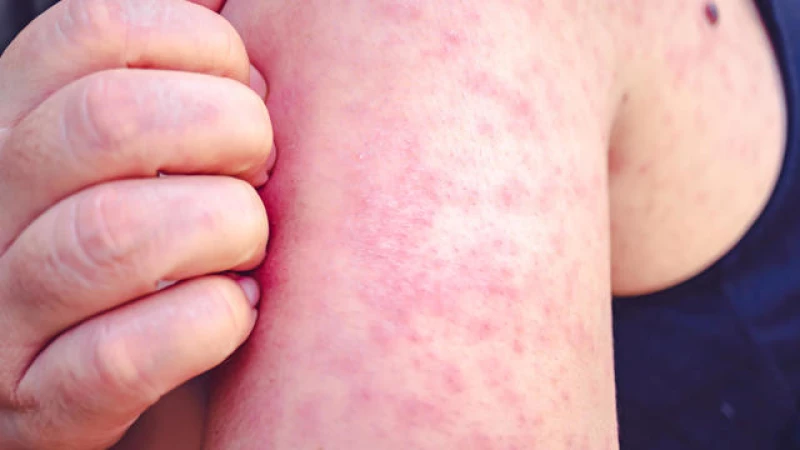The U.S. has now tallied at least 59 confirmed or suspected measles cases investigated so far this year by authorities in 17 states — more than the number of nationwide in all of 2023. It comes as health officials are grappling with multiple major outbreaks of the highly contagious virus around the world.
Now with spring break travel looming, health officials have ramped up pleas for Americans to double check whether they are up to date on the highly effective vaccines used to protect against measles.
The CDC updated its guidance Wednesday to counsel Americans who are unsure if they're up to date on their shots to seek out a doctor at least six weeks before their trip.
Here's what we know about the outbreaks so far this year.
Recent weeks have seen a surge in measles cases in Illinois, with a total of 12 infections reported in Chicago. Out of these cases, 10 were individuals staying at a migrant shelter. The remaining 2 cases are unrelated to the shelter outbreak, according to a spokesperson from the city's health department.
To address the situation, the CDC dispatched a team to Chicago on March 12 to collaborate with the city in investigating and containing the spread of the virus. The team is also providing support for the city's vaccination efforts.
Meanwhile, Florida has documented 10 cases of measles this year, with the majority originating from Broward County. An outbreak was identified in a Miami-area elementary school, prompting CDC laboratories to assist in determining the genotype of the virus responsible for the outbreak, which can aid in tracing its source.
Laboratory testing has confirmed most of the measles cases nationwide, with only two cases remaining suspected in Ohio's Clermont County and Arizona's Coconino County.
What is causing the increase in measles cases in 2024?
The rise in outbreaks this year in the U.S. has been attributed to unvaccinated travelers who have contracted the virus abroad and exposed individuals lacking immunity. Measles is highly contagious, with an infected person able to spread it for four days before showing symptoms. Typically, symptoms manifest around 11 days after exposure.
At least six cases this year were in people who were first exposed to the virus abroad, according to CDC data updated Thursday. Last year ended with 13 of these "imported" cases reported, as of the agency's preliminary tally from the end of December.
Parents may not be aware that babies are recommended to get a vaccine for measles before international travel as early as six months old, officials have said, while older travelers may not realize that their destinations are facing outbreaks.
Cases have been on the rise around the world, blamed on a wide gap in immunity in many countries resulting from missed vaccinations during the COVID-19 pandemic.
Records obtained by CBS News through a Freedom of Information Act request show the CDC had launched investigations of measles exposures through Feb. 20 in arriving international flights that departed from Saudi Arabia, Egypt and Turkey.
Health officials in Georgia and California have also confirmed at least one of their cases this year was linked to travel through the Middle East. Other outbreaks in recent months have also been linked to travel in other parts of the world like Europe, which has also been facing a resurgence of infections.
However, some recent clusters have also not been tied to international travel.
Louisiana's health department reported that their cases this year were exposed in another U.S. state. A spokesperson for Arizona's Coconino County mentioned that their recent cases had a connection to Louisiana.
When was the last time the U.S. saw a surge of measles cases?
Many of the infections in 2022 resulted from low immunity among the thousands of evacuees airlifted from Afghanistan that year, prompting a mass vaccination campaign to curb further spread.
This marked the largest number of measles infections on record nationwide since 1992, driven in part by outbreaks that continued for months among large, close-knit Orthodox Jewish communities in New York. Other countries around the world also saw major outbreaks that year.
At the time, federal health authorities worried the outbreaks could threaten the U.S. status of having eliminated the virus.
Recognizing the Symptoms of Measles
After approximately two weeks of exposure to someone with measles, the initial signs of the virus typically manifest in the form of a high fever and at least one of the following, known as "the three C's" of measles:
- Cough
- Runny nose, medically referred to as coryza
- Pink eye, known as conjunctivitis in the medical field
A couple of days later, a distinctive rash associated with measles appears, usually starting on the face and then spreading to the upper body. These rashes are usually non-itchy. Common complications include ear infections and diarrhea.
Medical tests are most effective in detecting measles infections when conducted by a healthcare professional at least three days after the rash first appears.
Individuals concerned about potentially having measles are advised to contact their healthcare provider or hospital in advance before seeking medical attention, considering the precautions necessary to prevent the highly contagious virus from spreading to other patients.
According to the CDC, approximately 1 in 5 unvaccinated Americans who contract measles require hospitalization.
During the peak of the 2019 outbreak, 5% of the hospitalized patients
Measles can be fatal, particularly in young children. Prior to the disease's eradication in the U.S. due to widespread vaccination efforts in the 1960s, an estimated two to three deaths occurred annually.







